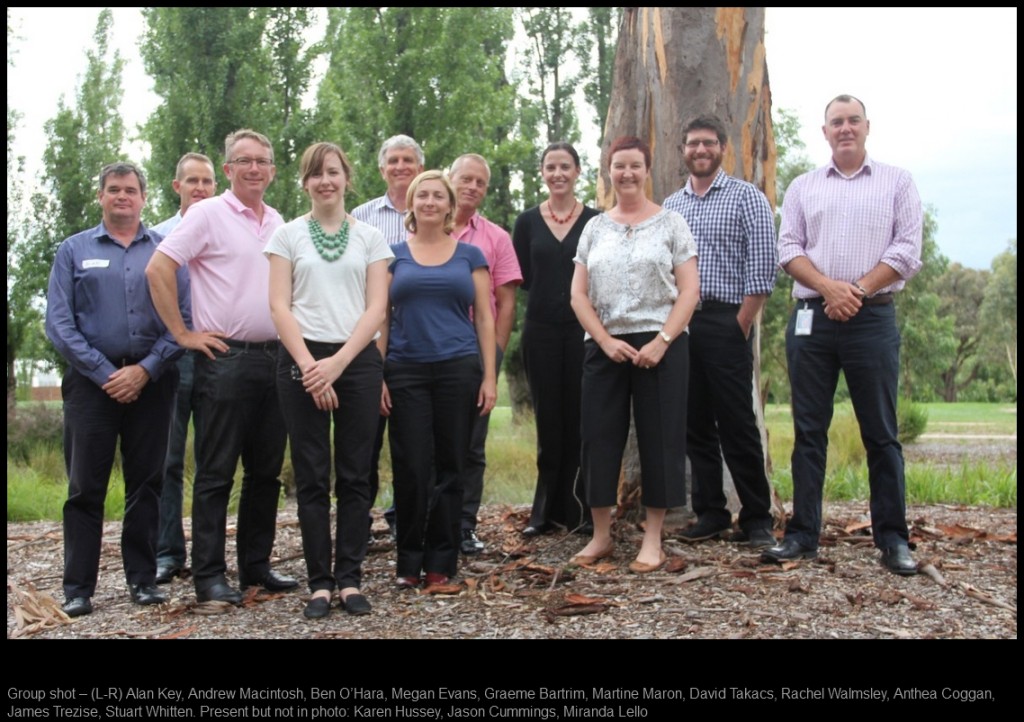This is a guest post by Megan Evans, a PhD researcher based at the Fenner School of Environment and Society, at the Australian National University in Canberra, Australia.
This comment has previously been published on Megan’s Blog. It is the expression of the author’s thoughts and experiences and as such is acknowledged as a fruitful contribution to the discussion on biodiversity offsets. If you want to react or clarify your own position (underpin or disprove Megan’s reasoning), please leave a reply below!
 Over two days in January 2015, fifteen academics and professionals from law, economics, business, ecology and policy came together to discuss biodiversity offsetting – but with a multi-disciplinary twist. Held at the Fenner School of Environment and Society at the Australian National University, and organised by Megan Evans, Stuart Whitten, Andrew Macintosh and Martine Maron, the overall goal of the workshop was to look at biodiversity offsetting from a range of different perspectives, and to try and understand how such policies can effectively deliver positive environmental outcomes.
Over two days in January 2015, fifteen academics and professionals from law, economics, business, ecology and policy came together to discuss biodiversity offsetting – but with a multi-disciplinary twist. Held at the Fenner School of Environment and Society at the Australian National University, and organised by Megan Evans, Stuart Whitten, Andrew Macintosh and Martine Maron, the overall goal of the workshop was to look at biodiversity offsetting from a range of different perspectives, and to try and understand how such policies can effectively deliver positive environmental outcomes.
Biodiversity offsetting is a highly topical and increasingly popular approach used to compensate for impacts on species and ecosystems as a result of development, and is the subject of a large and growing body of scientific research. There has been substantial work in developing offset metrics which can accurately measure biodiversity losses and gains over time, as well as discussion around the ecological limits of offsetting. However, there has been comparatively less attention paid to how the policy system as a whole influences the possible environmental outcomes from biodiversity offsetting.
For instance, what are the roles and responsibilities of key organisations involved in offsetting, how do these organisations interact, and do they have sufficient capacity and ‘fit for purpose’ information to implement and oversee offset policy? What institutional settings are in place to govern the offsetting process? What legal mechanisms are used to transfer and enforce offset obligations between different participants? Are there appropriately aligned incentives to stimulate market participation and to facilitate monitoring and compliance?
By considering these institutional and organisational dimensions of biodiversity offset markets, in addition to key criteria for the effective implementation of environmental policy, workshop participants were able to identify a range of issues arising from the offset implementation process which may be impeding positive outcomes for biodiversity.
Good design doesn’t automatically translate to good on-ground outcomes
Although it was recognised and agreed that the recently updated Australian environmental offsets policy guide had introduced scientific rigor and improved transparency in the calculation of offset requirements, this has not necessarily lead to improvements in other aspects of policy implementation. For example, it was pointed out that translating the offset requirements calculated at the design phase into on-ground implementation is still a rather complex process.
A better understanding by policy-makers of the challenges that on-ground offset providers can face (such as availability of native seed stock), and the unique insights these practitioners can bring to the table (such as knowledge of new management and restoration techniques), could help to ensure that the biodiversity outcomes that are promised by offset proposals are actually achieved on the ground.
Policy uncertainty leads to business uncertainty, which leads to uncertain biodiversity outcomes
Biodiversity offsetting is a rapidly evolving policy space, which means that government policies have been through a number of changes in a relatively short space of time. For example, the Queensland Government introduced on average, one new offset policy per year over the 2000’s. Although the introduction of new policies may often be motivated by a need to provide more guidance or to better address the problem at hand, the downside is that it continually shifts the goal-posts for businesses who need to comply with such policies when developing environmental impact statements and submitting development applications.
Securing an offset site which can provide adequate compensation for the impacts of a development is a long, complex and expensive process, requiring negotiation with many parties including landholders, banks, brokers, Federal, State and local governments and third-party offset providers. If a policy is changed or re-interpreted during this process, investments of what can sometimes be millions of dollars tied to an offset project may be at risk. This uncertainty can have a very real impact on what outcomes can be delivered by an offset policy.
People, culture and relationships are crucial parts of the process
Although the main concern about biodiversity offsetting is of course the species and ecosystems being impacted and compensated for, ultimately it is the individuals and organisations who implement the policy that can influence its effectiveness. For example, if information about what the offset requirements are, what legal mechanisms are needed to secure the offset, or what actions are required for regulatory compliance are not adequately communicated among all participants, this can result in offsets that provide less enduring and effective outcomes for biodiversity. Recognising that the motivations and objectives of individuals and organisations involved in offsetting will often differ, is crucial. Identifying where there may be opportunities to better align policy processes in a way that is mutually beneficial could help to improve outcomes for biodiversity through offsetting in the long term.
More changes are on the horizon, though not necessarily for the better
Biodiversity offsetting is certainly an active policy space in Australia. In addition to the recent Senate inquiry, there have been new policies introduced in Queensland and New South Wales during 2014. Concerns have been raised about the relaxation of key policy principles in these new policies, such as the ‘like-for-like’ principle (ensuring an offset is the same species or ecosystem type as the one impacted), permitting mine rehabilitation (which is already required under the NSW Mining Act) to be counted as an offset, and allowing up to 100% of an offset to be ‘indirect’ (which is really a change in the definition of the term ‘offset’). Although these changes have likely been driven by politics rather than science, this is simply a reality in the making of public policy – which results from an interaction between different values, interests and resources. The role which researchers can take in this process is to do provide the best possible science, while remaining cognisant of this broader contestation of ideas.
This workshop was generously supported by the CSIRO and the ARC Centre of Excellence for Environmental Decisions.

Very useful note on the workshop which resonates with the developing UK system. We still have too much ignorance of the benefits of the system here because commentators have not read all the documentation and still think it is a licence to trash. In fact it is the reverse. In the UK the issue is more about capturing the impacts on relatively low levels of biodiversity from general, but nonetheless, large scale development currently happening (eg 1 million houses currently in the planning system that will create substantial cumulative impacts in the wider countryside yet almost no compensation is currently being secured). Had offsetting been adopted for these it would have provided more investment annually into the natural environment than we currently provide through all our agri-environment schemes (which are anyway, short-term offset funding mechanisms given to farmers for the environmental impacts created by farming). The government, despite being advised and recommended to adopt a mandatory approach through the planning system, is currently only interested in a voluntary approach which makes it difficult to build a market. One county in the UK has adopted a mandatory approach and it is the only area where offsetting is scaling up. It will, over a relatively short time period, provide a massive boost to wildlife habitat in that part of the country and also funding for planning authority ecologists to undertake the metric calculations of all developments in the future. As we get this approach to work, the model is highly likely to scale-up across the country, enabling a transparent mechanism by which planning authorities can deliver their legal biodiversity duties.
Very interesting note on your workshop! I was particularly interested to note your remarks about the complexity and challenges of actually securing and managing appropriate site for biodiversity offsetting. The need for multi-stakeholder work to ensure sites are properly developed and managed is crucial to their success. Unfortunately, I’ve found that in the UK there there is often too little understanding or trust amongst many of the stakeholders that need to be involved — hence the unhelpful knee-jerk reaction of some environmentalist that biodiversity offsetting is “a licence to trash”. Perhaps it would help if the development and publication of more work was facilitated that highlights the multidisciplinary and multi-stakeholder nature of the issues involved.
Love your analysis of the situation in the UK, Derrick! It is frustrating that so much energy is spent debating and campaigning against each other when the best outcome can always be achieved if there is understanding and cooperation among stakeholders…